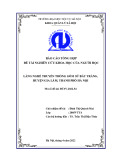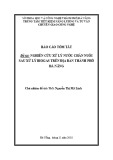
Hindawi Publishing Corporation
EURASIP Journal on Wireless Communications and Networking
Volume 2007, Article ID 63503, 14 pages
doi:10.1155/2007/63503
Research Article
Grey Target Tracking and Self-Healing on
Vehicular Sensor Networks
Yih-Fuh Wang1and Lin-Lin Liu2
1Department of Computer Science and Information Management, Leader University, No. 188 Sec. 5 Anjhong Rd.,
Tainan 709 , Taiwan
2Institute of Applied Information, Leader University, No. 188 Sec. 5 Anjhong Rd., Tainan 709 , Taiwan
Received 3 October 2006; Revised 30 January 2007; Accepted 6 April 2007
Recommended by Biao Chen
The wireless vehicular sensor network (VSN) has been very useful for many transportation application systems, but it does not
operate like the traditional wireless sensor network. For safety reason, the vehicle-vehicle and vehicle-gateway communication
modes must be stable. The motion of the vehicle, the environment of the roads, and other uncertain traffic conditions all pose
challenges to the system. Therefore, how to keep link stability becomes an important issue. In this paper, we propose a scheme that
uses grey target tracking to self-heal or reroute in advance the weak link on an alternative route as failure occurs and makes the
whole vehicular sensor network more stable. Although this scheme increases the average latency and control overhead, it supports
higher survivability and effective reflections on rerouting.
Copyright © 2007 Y.-F. Wang and L.-L. Liu. This is an open access article distributed under the Creative Commons Attribution
License, which permits unrestricted use, distribution, and reproduction in any medium, provided the original work is properly
cited.
1. INTRODUCTION
The wireless vehicular sensor network (VSN) has been widely
investigated and proved to be very useful for trafficpat-
tern analysis, road surface diagnosis, urban environmental
monitoring, or street-level air pollution monitoring [1]. Un-
like the traditional wireless sensor network (WSN), VSN is
composed of hundreds or thousands of low-cost, low-power,
multifunctional, and small sensors [2,3].TheVSNhashigh
computational power, provides high storage space, and has
enough energy in mobile sensor nodes. In practice, it is
mainly employed for supporting car safety, such as exchang-
ing safety-relevant information or remote diagnostics using
data from sensors built into vehicles, and mobile Internet ac-
cess.
In a VSN, each vehicle is responsible for sensing one or
more events, routing messages to other vehicles or road-
side base stations, and processing sensed data. As shown in
Figure 1, there are some moving vehicles and communica-
tion devices serving as base stations installed along the roads.
For that, car safety can be protected by early broadcasting to
police or neighbor cars as accidents occur. Then, a VSN is
also able to forward these accident information related to car
condition directly to roadside base stations or distant police
or emergency centers so that they can make necessary emer-
gency response and medical treatment decisions as soon as
possible [4]. Moreover, the roadside base stations broadcast
or multicast it to neighbor cars to avoid more accidents.
The VSN can be used in many cost-effective ways [4,5]
to gather traffic information to better understand how traffic
knots, and point out the situation in order to reduce conges-
tion, minimize emission, decrease fuel consumption, or fos-
ter traffic security. How vehicular ad hoc network (VANET)
built VSN by equipping vehicles with onboard sensor devices
has been introduced by [4,5] (see Figure 1). The solution for
car safety communication in VSN is to use intervehicle com-
munication (IVC) [6]. As the vehicles move along the road,
the propagation of the information should follow the same
one-dimensional movement. Another difference is related
to the fact that in case of IVC, all vehicles are moving and
their relative speed with respect to each other is very small,
resulting in stable wireless links between vehicles. US FCC
has allocated a block of spectrum from 5.85 to 5.925 GHz
band for IVC and vehicle-to-road communications (VRCs)
that can support a wide range of applications [7]. One com-
bined vehicular communication [7] is built with IVC, cellular






























